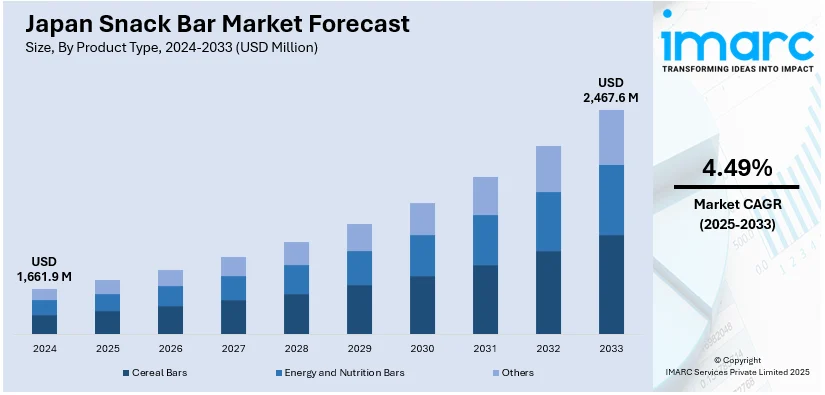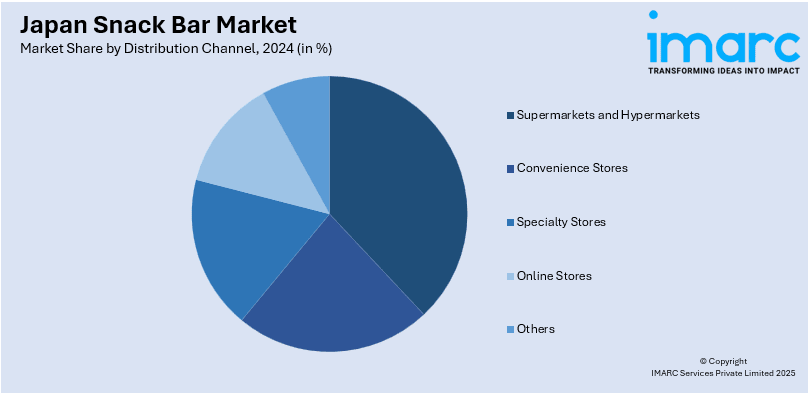
Japan Snack Bar Market Size, Share, Trends and Forecast by Product Type, Ingredient, Distribution Channel, and Region, 2025-2033
Japan Snack Bar Market Overview:
The Japan snack bar market size reached USD 1,661.9 Million in 2024. Looking forward, IMARC Group expects the market to reach USD 2,467.6 Million by 2033, exhibiting a growth rate (CAGR) of 4.49% during 2025-2033. The market is propelled by heightening consumer awareness of health, urbanization, and demand for convenient, nutrient-dense foods. Premium flavor innovations and natural ingredients further drive the appeal of products, as consumer dietary and lifestyle habits continue to shift.
|
Report Attribute
|
Key Statistics
|
|---|---|
|
Base Year
|
2024
|
|
Forecast Years
|
2025-2033
|
|
Historical Years
|
2019-2024
|
| Market Size in 2024 | USD 1,661.9 Million |
| Market Forecast in 2033 | USD 2,467.6 Million |
| Market Growth Rate 2025-2033 | 4.49% |
Japan Snack Bar Market Trends:
Integration of Traditional Japanese Flavors into Modern Snack Bar Formulations
The use of traditional Japanese ingredients within modern snack bar packaging has emerged as a prominent trend, as consumers increasingly seek out familiar, culturally based flavors in convenient, modern packaging. Ingredients like matcha, yuzu, azuki beans, black sesame, and kinako (roasted soybean flour) are becoming more prominent in snack bars, providing both nostalgic values and distinctive taste profiles that distinguish them in international markets. Such components not only impart flavor but also add functional health value, commensurate with changing consumer demands for healthy snacking. The Japan snack bar market outlook, is promising, driven by robust domestic demand and expanding international interest. In response, manufacturers are innovating to meet evolving consumer expectations both within Japan and abroad. This blending of flavors is a convergence of tradition and innovation, drawing across various consumer groups from the health-oriented to those looking for novelty in snack foods with an authentic cultural touch.

Rising Popularity of Plant-Based and Functional Snack Bars
An increasing number of Japanese consumers are prioritizing nutrition, sustainability, and ethical sourcing in their dietary choices, leading to a growing demand for functional and plant-based snack bars. For instance, in March 2023, 7-Eleven Japan introduced three flavors of Seven Premium tofu bars with the Sustainable U.S. Soy logo to encourage environmentally friendly snacking in line with increasing Japanese consumer interest in sustainability and convenience. Moreover, these products traditionally include ingredients of soy protein, nuts, seeds, seaweed, and grain, which in many cases may be fortified with vitamins, minerals, and probiotics to advance their nutritional density. This trend aligns with a preventive health and natural energy lifestyle, which appeals to urban consumers and fitness buffs. In addition, the focus on clean labeling and low processing aligns with a consumer group that demands transparency and ingredient simplicity. The Japan snack bar market share has experienced upward movement as a result of this trend, as these bars provide convenient, on-the-go nutrition without sacrificing dietary integrity. With the trend continuing to develop, functional components with targeted requirements like beauty, digestion, and mental well-being are likely to become more prominent in the domestic market.
Emphasis on Premiumization and Artisanal Appeal
Japanese snack bar creators are highly emphasizing premiumization, providing premium products with artisanal quality and advanced design. This is influenced by consumers' desire to spend money on improved-for-you snacks that provide a superior sensory experience. Packaging style, ingredient sourcing, and complexity of flavors are key to this movement, with attention to detail mirroring the cultural value for advanced and minimalism. For example, in March 2023, Otsuka Pharmaceutical introduced SOYJOY Fruits & Cheese, a baked cheesecake-flavored whole-soy nutrition bar with pineapple and apple, to serve Japan's health-conscious consumers looking for low-GI, plant-based, gluten-free, and fiber-rich snacking. Furthermore, limited edition bars, locally sourced ingredients, and seasonally changing products introduce exclusivity and storytelling depth, positioning the snack not only as functional but as a treat to enjoy. Consequently, Japan snack bar market growth is being fueled by value-driven consumption over pure volume. This trend is consistent with larger lifestyle choices that prefer edited, thoughtful consumption and can impact international snack trends based on Japan's reputation for quality and innovation in food presentation and flavor.
Japan Snack Bar Market Segmentation:
IMARC Group provides an analysis of the key trends in each segment of the market, along with forecasts at the region level for 2025-2033. Our report has categorized the market based on product type, ingredient, and distribution channel.
Product Type Insights:
- Cereal Bars
- Granola/Muesli Bars
- Others
- Energy and Nutrition Bars
- Others
The report has provided a detailed breakup and analysis of the market based on the product type. This includes cereal bars (granola/muesli bars and others), energy and nutrition bars, and others.
Ingredient Insights:
- Nuts
- Whole Grains
- Dried Fruits
- Others
A detailed breakup and analysis of the market based on the ingredient have also been provided in the report. This includes nuts, whole grains, dried fruits, and others.
Distribution Channel Insights:

- Supermarkets and Hypermarkets
- Convenience Stores
- Specialty Stores
- Online Stores
- Others
The report has provided a detailed breakup and analysis of the market based on the distribution channel. This includes supermarkets and hypermarkets, convenience stores, specialty stores, online stores, and others.
Regional Insights:
- Kanto Region
- Kansai/Kinki Region
- Central/ Chubu Region
- Kyushu-Okinawa Region
- Tohoku Region
- Chugoku Region
- Hokkaido Region
- Shikoku Region
The report has also provided a comprehensive analysis of all the major regional markets, which include Kanto Region, Kansai/Kinki Region, Central/Chubu Region, Kyushu-Okinawa Region, Tohoku Region, Chugoku Region, Hokkaido Region, and Shikoku Region.
Competitive Landscape:
The market research report has also provided a comprehensive analysis of the competitive landscape. Competitive analysis such as market structure, key player positioning, top winning strategies, competitive dashboard, and company evaluation quadrant has been covered in the report. Also, detailed profiles of all major companies have been provided.
Japan Snack Bar Market News:
- In February 2024, Nissui Corporation and Suzuhiro Kamaboko Co., Ltd. have expanded Japan’s protein snack market with the launch and evolution of their fish-based protein bars. Nissui’s Osakana Bar, introduced in Spring 2023, features surimi with ingredients like edamame and cheese, while Suzuhiro’s Fish Protein Bar offers a convenient, on-the-go protein source.
- In February 2024, South Korea's Pulmuone announced a 241% increase in sales of its plant-based "Tofu Bar" in Japan, a chilled protein snack bar comprising tofu with 10g of protein per bar. The popular, soft and chewy, snack is being sold in 30,000 outlets such as 7-Eleven and FamilyMart as part of Japan's growing trend towards convenient, healthy snack bar options.
Japan Snack Bar Market Report Coverage:
| Report Features | Details |
|---|---|
| Base Year of the Analysis | 2024 |
| Historical Period | 2019-2024 |
| Forecast Period | 2025-2033 |
| Units | Million USD |
| Scope of the Report |
Exploration of Historical Trends and Market Outlook, Industry Catalysts and Challenges, Segment-Wise Historical and Future Market Assessment:
|
| Product Types Covered |
|
| Ingredients Covered | Nuts, Whole Grains, Dried Fruits, Others |
| Distribution Channels Covered | Supermarkets And Hypermarkets, Convenience Stores, Specialty Stores, Online Stores, Others |
| Regions Covered | Kanto Region, Kansai/Kinki Region, Central/Chubu Region, Kyushu-Okinawa Region, Tohoku Region, Chugoku Region, Hokkaido Region, Shikoku Region |
| Customization Scope | 10% Free Customization |
| Post-Sale Analyst Support | 10-12 Weeks |
| Delivery Format | PDF and Excel through Email (We can also provide the editable version of the report in PPT/Word format on special request) |
Key Questions Answered in This Report:
- How has the Japan snack bar market performed so far and how will it perform in the coming years?
- What is the breakup of the Japan snack bar market on the basis of product type?
- What is the breakup of the Japan snack bar market on the basis of ingredient?
- What is the breakup of the Japan snack bar market on the basis of distribution channel?
- What is the breakup of the Japan snack bar market on the basis of region?
- What are the various stages in the value chain of the Japan snack bar market?
- What are the key driving factors and challenges in the Japan snack bar?
- What is the structure of the Japan snack bar market and who are the key players?
- What is the degree of competition in the Japan snack bar market?
Key Benefits for Stakeholders:
- IMARC’s industry report offers a comprehensive quantitative analysis of various market segments, historical and current market trends, market forecasts, and dynamics of the Japan snack bar market from 2019-2033.
- The research report provides the latest information on the market drivers, challenges, and opportunities in the Japan snack bar market.
- Porter's five forces analysis assist stakeholders in assessing the impact of new entrants, competitive rivalry, supplier power, buyer power, and the threat of substitution. It helps stakeholders to analyze the level of competition within the Japan snack bar industry and its attractiveness.
- Competitive landscape allows stakeholders to understand their competitive environment and provides an insight into the current positions of key players in the market.
Need more help?
- Speak to our experienced analysts for insights on the current market scenarios.
- Include additional segments and countries to customize the report as per your requirement.
- Gain an unparalleled competitive advantage in your domain by understanding how to utilize the report and positively impacting your operations and revenue.
- For further assistance, please connect with our analysts.
 Request Customization
Request Customization
 Speak to an Analyst
Speak to an Analyst
 Request Brochure
Request Brochure
 Inquire Before Buying
Inquire Before Buying




.webp)




.webp)












